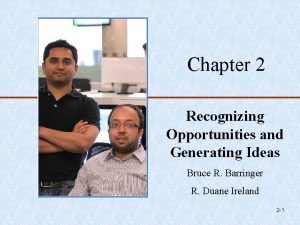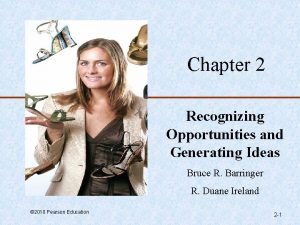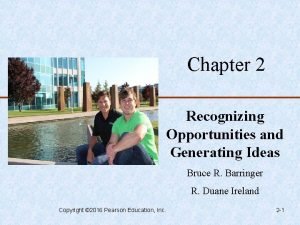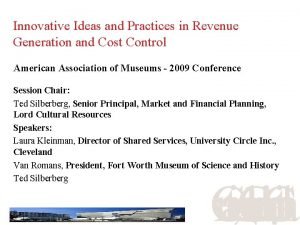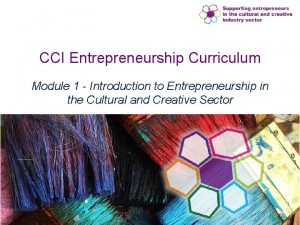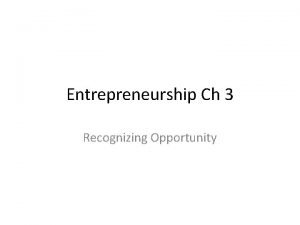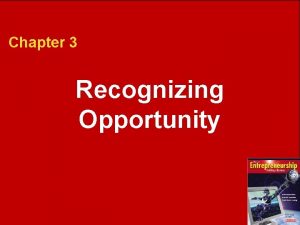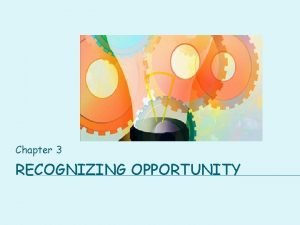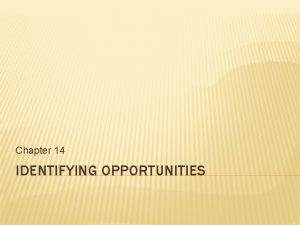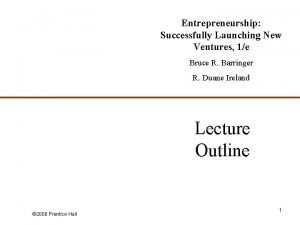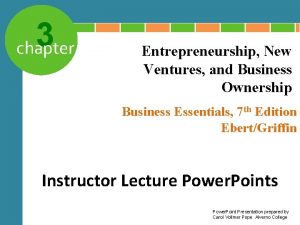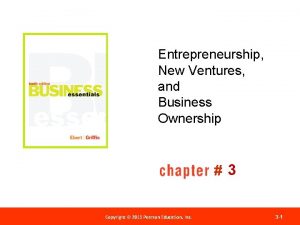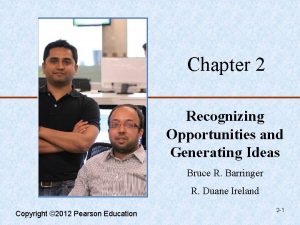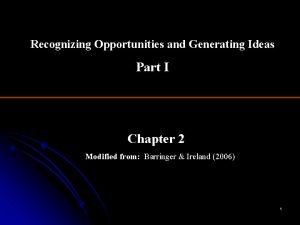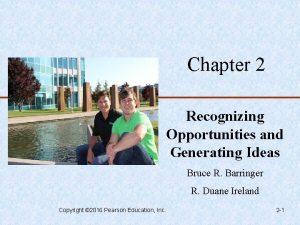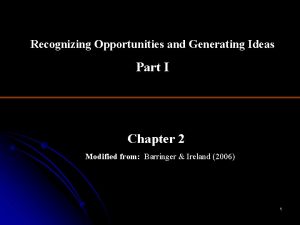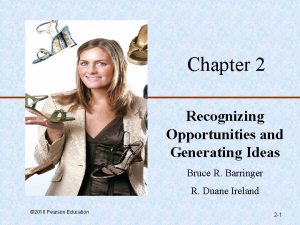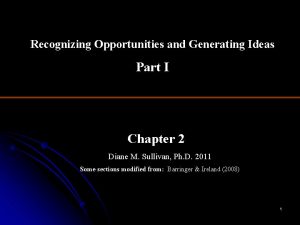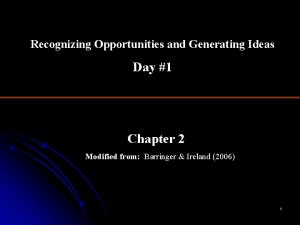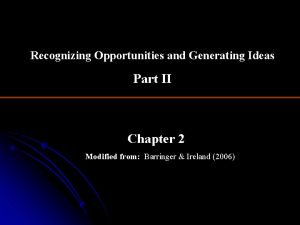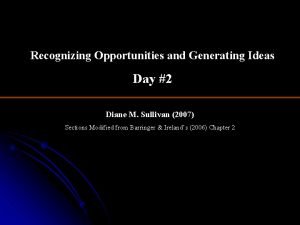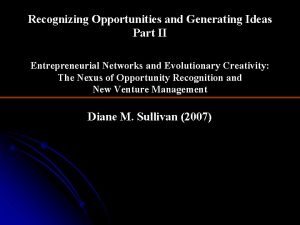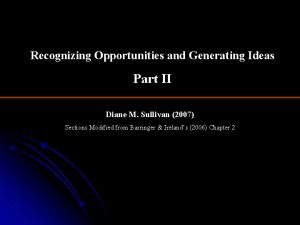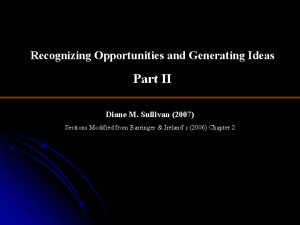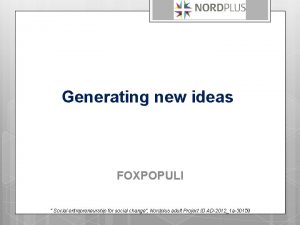Entrepreneurship Recognizing Opportunities Generating New Ideas Chapter 2





















- Slides: 21

Entrepreneurship: Recognizing Opportunities & Generating New Ideas Chapter 2 © 2008 Prentice Hall

Chapter Objectives (1 of 2) 1. Explain why it’s important to start a new firm when its “window of opportunity” is open. 2. Explain the difference between an opportunity and an idea. 3. Describe three general approaches entrepreneurs use to identify opportunities. 4. Identify the four environmental trends that are most instrumental in creating business opportunities. © 2008 Prentice Hall

What is An Opportunity? (1 of 2) • Business Opportunity An opportunity is a favorable set of circumstances that creates the need for a new product, service, or business idea. © 2008 Prentice Hall

Opening Case: Entrepreneur Got Success Tony Hsieh • Coming out of Harvard • Launched his first internet company “Link. Exchange”. • Sold it to Yahoo in $265 mill. • Started zappos. com • Sold it to Amazon in 2009 for $1. 2 Bill. © 2008 Prentice Hall

Window of Opportunity • Window of Opportunity The term “window of opportunity” is a metaphor describing the time period in which a firm can realistically enter a new market. • At some point, the market matures, and the window of opportunity (for new entrants) closes. © 2008 Prentice Hall

What is an Opportunity? (2 of 2) An opportunity has four essential qualities © 2008 Prentice Hall

Three Ways to Identify An Opportunity © 2008 Prentice Hall

First Approach: Observing Trends (2 of 2) Environmental Trends Suggesting Business or Product Opportunity Gaps © 2008 Prentice Hall

Trend 1: Economic Forces • Economic Forces – Economic forces affect consumers’ level of disposable income. – When studying how economic forces affect opportunities, it is important to evaluate who has money to spend and who is trying to cut costs. • An increase in the number of women in the workforce and their related increase in disposable income is largely responsible for the number of boutique clothing stores targeting professional women that have opened in the past several years. • Many large firms are trying to cut costs. Entrepreneurs have taken advantage of this trend by starting firms that help other firms control costs. © 2008 Prentice Hall

Trend 2: Social Forces (1 of 2) • Social Forces – Changes in social trends provide openings for new businesses on an ongoing basis. – The continual proliferation of fast-food restaurants, for example, isn’t happening because people love fast food. It is happening because people are busy, and have disposable income. – Similarly, the Sony Walkman was developed not because consumers wanted smaller radios but because people wanted to listen to music while on the go. © 2008 Prentice Hall

Trend 2: Social Forces (2 of 2) Examples of Social Forces That Allow For New Business Opportunities • Family and work patterns. • The aging of the population. • The increasing diversity in the workplace. • The globalization of industry. • The increasing focus on health care and fitness. • The proliferation of computers and the Internet. • The increase in the number of cell phone users. • New forms of entertainment. © 2008 Prentice Hall

Trend 3: Technological Advances • Technological Advances – Given the rapid pace of technological change, it is vital that entrepreneurs keep on top of how new technologies affect current and future business opportunities. – Entire industries have emerged as the result of technological advances. • Examples include the computer industry, the Internet, biotechnology, and digital photography. – Once a new technology is created, new businesses form to take the technology to a higher level. • For example, Real. Networks was started to add audio capability to the Internet. © 2008 Prentice Hall

Trend 4: Political and Regulatory Changes • Political and Regulatory Changes – Political and regulatory changes provide the basis for new business opportunities. • For example, laws that protect the environment have created opportunities for entrepreneurs to start firms that help other firms comply with environmental laws and regulations. • Similarly, many entrepreneurial firms have been started to help companies comply with the Sarbanes-Oxley Act of 2002. The act requires certain companies to keep all their records, including e -mail messages and electronic documents, for at least five years. © 2008 Prentice Hall

Second Approach: Solving a Problem (1 of 2) Second Approach: Solving a Problem Sometimes identifying opportunities simply involves noticing a problem and finding a way to solve it. These problems can be pinpointed through observing trends and through more simple means, such as intuition or chance. Some business ideas are clearly initiated to solve a problem. For example, Symantec Corp. created Norton antivirus software to guard computers against viruses. © 2008 Prentice Hall

Second Approach: Solving a Problem (2 of 2) Businesses Created to Solve a Problem © 2008 Prentice Hall

Third Approach: Finding Gaps in the Marketplace • Gaps in the Marketplace – A third approach to identifying opportunities is to find a gap in the marketplace. – A gap in the marketplace is often created when a product or service is needed by a specific group of people but doesn’t represent a large enough market to be of interest to mainstream retailers or manufacturers. • This is the reason that small clothing boutiques and specialty shops exist. • The small boutiques, which often sell designer clothes or clothing for hard-to-fit people, are willing to carry merchandise that doesn’t sell in large enough quantities for Wal-Mart, GAP, or JC Penney to carry. © 2008 Prentice Hall

Full View of the Opportunity Recognition Process Depicts the connection between an awareness of emerging trends and the personal characteristics of the entrepreneur © 2008 Prentice Hall

Techniques For Generating Ideas Brainstorming Focus Groups Surveys Other Techniques © 2008 Prentice Hall

Brainstorming (1 of 2) • Brainstorming – Is a technique used to generate a large number of ideas and solutions to problems quickly. – A brainstorming “session” typically involves a group of people, and should be targeted to a specific topic. – Rules for a brainstorming session: • • No criticism. Freewheeling is encouraged. The session should move quickly. Leap-frogging is encouraged. © 2008 Prentice Hall

Focus Groups • Focus Group – A focus group is a gathering of five to ten people, who have been selected based on their common characteristics relative to the issues being discussed. – These groups are led by a trained moderator, who uses the internal dynamics of the group environment to gain insight into why people feel they way they do about a particular issue. – Although focus groups are used for a variety of purposes, they can be used to help generate new business ideas. © 2008 Prentice Hall

Surveys (1 of 2) • Survey – A survey is a method of gathering information from a sample of individuals. The sample is usually just a fraction of the population being surveyed. • The most effective surveys sample a “random” portion of the population, meaning that the sample is not selected haphazardly or only from people who volunteer to participate. • The quality of survey data is determined largely by the purpose of the survey and how it is conducted. – Surveys generate new product, service, and business ideas because they ask specific questions and get specific answers. © 2008 Prentice Hall
 Trends and opportunities examples
Trends and opportunities examples An opportunity has four essential qualities it is
An opportunity has four essential qualities it is Recognizing opportunities
Recognizing opportunities Recognizing opportunities and generating ideas
Recognizing opportunities and generating ideas Revenue generating ideas for museums
Revenue generating ideas for museums Introduction to entrepreneurship module pdf
Introduction to entrepreneurship module pdf What is new entry
What is new entry Entrepreneurial trends
Entrepreneurial trends Chapter 3 recognizing opportunity
Chapter 3 recognizing opportunity Chapter 13 worksheet recognizing different sports injuries
Chapter 13 worksheet recognizing different sports injuries Chapter 3 recognizing opportunity
Chapter 3 recognizing opportunity Recognizing opportunity
Recognizing opportunity Identifying business opportunities
Identifying business opportunities Successfully launching new ventures
Successfully launching new ventures Entrepreneurship new ventures and business ownership
Entrepreneurship new ventures and business ownership Entrepreneurship new ventures and business ownership
Entrepreneurship new ventures and business ownership Entrepreneurship new ventures and business ownership
Entrepreneurship new ventures and business ownership What is useful materials
What is useful materials Strategy: listening for cognates
Strategy: listening for cognates Argumentative text anchor chart
Argumentative text anchor chart Process of channel design
Process of channel design Recognizing lab safety worksheet answers
Recognizing lab safety worksheet answers
